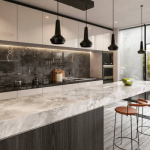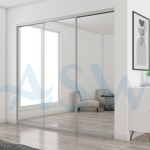A Complete Guide to Bathroom Tile Materials: Porcelain, Ceramic, Stone and More

Walking into a tile showroom can feel overwhelming – rows upon rows of samples, each promising to transform your bathroom into something special. From glossy finishes to textured patterns, the variety can be both exciting and confusing, especially when trying to strike the right balance between beauty, practicality, and budget. This guide walks you through the most popular tile materials used in Australian bathrooms, highlighting their unique features, pros, and cons, as well as where they work best. Whether you’re sourcing tiles in Melbourne or designing a coastal-inspired bathroom in Queensland, this article will help you make smart, confident tile choices tailored to your needs.
Why Tile Choice Matters in Bathrooms
Bathrooms are wet zones by nature, and the materials you choose must withstand daily exposure to moisture, humidity, and heat. Not all tiles are created equal—some offer better water resistance, durability, or slip resistance than others, which can affect not only your safety but the long-term performance of your space.
A thoughtfully tiled bathroom with a thoughtful colour combination and quality materials can elevate the feel and resale value of your home.
In Australia, slip ratings are an important safety concern, particularly in wet areas. Look for the R-rating system when selecting floor tiles to ensure they meet slip resistance standards (AS 4586) and that the waterproofing complies with AS 3740.
Tile Material Breakdown
Porcelain Tiles
Porcelain is the superhero of bathroom tiles – incredibly dense, virtually waterproof, and tough as nails. Available in glossy, matte, or textured finishes that mimic everything from timber to marble, porcelain handles wet zones like a champion.
The downside? It’s harder to cut and can feel cold underfoot.
While the upfront cost is higher than that of ceramic, the durability and low maintenance make it a brilliant value in the long term. Perfect for shower floors, walls, and high-traffic family bathrooms.
Ceramic Tiles
Ceramic tiles are a friendly and affordable option that still delivers great results. Lighter and easier to work with than porcelain, they offer fantastic design possibilities – vibrant colours, funky patterns, and glossy finishes that really stand out.
They’re slightly more porous than porcelain, so better suited to walls and low-traffic areas like powder rooms rather than shower floors.
Regular cleaning keeps them looking fresh, and they’re brilliant for adding personality without breaking the bank.
Think feature walls, splashbacks, or anywhere you want colour and pattern.
Natural Stone Tiles (Marble, Travertine, Slate)
Natural stone brings a serious luxury vibe – each piece is unique, with gorgeous, organic textures that manufactured tiles can’t match.
- Marble screams elegance
- Travertine offers natural slip resistance
- Slate provides that sophisticated, earthy feel
The catch? They need regular sealing and careful maintenance. Marble is a rare and in-demand material, and processing it into tiles is labour-intensive, consequently resulting in a higher price point. Stone tiles, on the other hand, could be a more cost-effective alternative.
Best for feature walls or spacious bathrooms where they can truly shine.
Glass Tiles
Glass tiles are absolute stars for creating light and making rooms feel larger. Perfect for brightening up darker bathrooms or adding a touch of sparkle to feature walls. They’re hygienic, easy to clean, and come in amazing colours.
Glass, unfortunately, is not great for floors. They can be slippery and are prone to scratching and cracking under pressure.
Stick to using them as accent strips, backsplashes, or mosaic features.
Other Options
Don’t overlook timber-look porcelain – it gives you that warm, natural timber vibe without the maintenance headaches of real wood in wet areas. Terrazzo is making a comeback with its speckled, retro charm, while cement tiles offer incredible pattern possibilities if you’re wanting something truly unique.
Factors to Consider When Choosing Bathroom Tiles
When planning a bathroom, think beyond just “what looks good.”
Style & Aesthetics
Do you want a spa retreat, a coastal escape, or a minimal modern look? Choose a tile style that supports your design theme—Hamptons, industrial, Scandi, or classic.
Functionality
Ensure floor tiles are non-slip (check for R10 or above in wet areas). For walls, decorative tiles are fine. For floors or shower areas, prioritise water resistance and durability.
Maintenance
Stone tiles require sealing. Glossy tiles show water spots. Small mosaic tiles mean more grout to clean. Consider how much effort you’re willing to put into upkeep.
Budget
Some tiles may seem affordable upfront, but they often carry higher installation costs due to their composition and fragility. Also factor in underlayments, waterproofing, trims, and waste.
Room Size & Light
Use large-format tiles to make small bathrooms feel bigger. Light tiles reflect more light, while darker tones can add drama but may close in the space.
Expert Tips for Selecting & Installing Tiles
Mix things up with different textures and finishes—matte tiles on the floor and gloss on the walls can add contrast and interest.
In smaller bathrooms, opt for large-format tiles to minimise grout lines and achieve a seamless appearance. Play with laying patterns like herringbone or stacked verticals for visual punch. The right grout colour can either blend in or highlight your design—just know that darker grout hides dirt better.
Lighting matters too—reflective tiles bounce light around, while matte tiles absorb it and soften its intensity.
Common Mistakes to Avoid
One of the biggest mistakes? Choosing tiles based on looks alone. That high-gloss white tile might look stunning, but it could become a slippery hazard in the shower.
Poor waterproofing is another common issue—if water seeps behind your tiles, you’re looking at costly repairs down the track.
Tiny grout lines mean more cleaning and can discolour quickly if not sealed or maintained. Also, DIY tiling might seem like a money-saver, but unless you’ve got the skills, it’s better left to the pros.
The right bathroom tile does more than look good—it keeps your space safe, functional, and easy to maintain. From porcelain to stone, every material has its strengths and quirks. Take your time, weigh up both looks and lifestyle needs, and make choices that suit your space. And if you’re still unsure, don’t stress—chat to a local tile expert or interior designer who knows how to balance style with smarts.






























